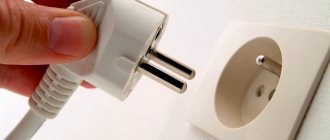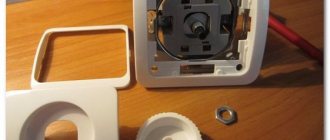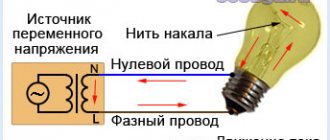Causes of sparks in an outlet
As noted in several previous publications on our website, such manifestations are characteristic of poor contact. Therefore, the reasons must be sought directly in the plug connector. List all possible options:
- Inconsistency in the standards of the main elements of the contact connector, that is, sockets and plugs.
- Connecting several powerful electrical appliances through an extension cord or tee, which leads to an electrical overload.
- Worn connectors caused by various reasons.
- Loosening of contact clamps.
- Poor quality electrical installation products, in this case sockets.
Let us consider in detail each of the listed options.
Plug and socket mismatch
Let us immediately note that this is one of the most common causes of malfunction. The fact is that the sockets are old-style, produced during the Soviet Union, designed for electrodes Ø 4.0 mm. Modern household appliances are equipped with Shuko plugs with thicker electrodes Ø 4.80 mm.
a) Soviet standard plug; c) Shucko fork
It would seem that the difference in the diameters of the electrodes of the plug design is less than a millimeter, but this leads to the fact that when you try to plug a Shucko plug into a Soviet-standard socket, you can damage the body of the latter or stretch the contact jaws. As a result, if you try to connect devices with an old plug into a given socket, sparking will be observed due to weak contact. A similar effect will be observed if a Soviet plug is plugged into a modern outlet.
Overcurrent
Like any electrical connector, a plug socket has its own characteristics that determine the permissible connection parameters. Simply put, if the permissible current of 16.0 A is indicated on the installation electrical device, then it is allowed to include electrical appliances with a total power of no more than 3.50 kW. How to calculate the permissible power from the rated current will be discussed separately.
Indication of the rated current on the socket body
Those who do not want to bother themselves with calculations can use the table below.
Table 1. Correspondence of the rated current of the socket to its power.
| Rated current parameters (A) | Rated power (W) |
| 6,0 | 1300,0 |
| 10,0 | 2200,0 |
| 16,0 | 3500,0 |
| 32,0 | 7000,0 |
If the permissible load is exceeded, the contacts of the socket connectors will begin to heat up. This leads to the fact that the conductors connected at the connection points begin to gradually burn, increasing the contact resistance, causing even greater heating and sparking. That is why it is not recommended to repeatedly connect electrical appliances through a tee or splitter. If this becomes necessary, it is better to install double sockets.
How to calculate the power of an outlet?
To do this, use Ohm's law for an alternating current circuit. In our case, the formula will have the following form: P = I*U*cos φ, where:
- P is the required permissible load power;
- I – permissible rated current value (indicated on the socket or in the technical documentation for it);
- U – voltage of the electrical network, at home – 220.0 V;
- cos φ – the value of the power factor; if it is not indicated on the electrical appliance connected to the outlet, then we take the value 0.95.
Let's give an example of a calculation. Let's say we have a 16 A socket, which means the permissible load power on it will be equal to 3344.0 W (16 x 220 x 0.95). As you can see, the calculated value is slightly less than the value in Table 1. That is why it is not recommended to load the outlet to the maximum. There is another reason to avoid maximum loads, which will be discussed further.
Worn socket connectors
The contact terminals are the weakest link in the design of the plug connector. Sooner or later they weaken and cannot fix the plug electrodes with sufficient force. As a result, the reliability of the electrical contact decreases, which leads to sparks and damage to the socket (if measures are not taken in time).
Result of connector wear
It is believed that such a malfunction is typical only for sockets that have been in use for a long time. This is not entirely true, the fact is that plug connectors are not designed for frequent switching on/off of electrical appliances. For this purpose, the latter have switches. If you plug electrical appliances into the outlet several times a day, its resource will be reduced and it will last significantly less than the period specified by the manufacturer.
Loose screw terminals
The condition of the contact clamps plays an important role in the reliability of the plug connector. Over time, they can weaken and the connections between the wires begin to heat up. What this can lead to has already been described above.
Socket contact screw terminals
This problem is especially typical for old wiring, the installation of which was carried out with a cable with aluminum conductors. This metal is characterized by characteristic fluidity. As a result, the pressure exerted on it by the contact pad over time causes the aluminum to “float”, causing the electrical contact in the screw terminal to weaken. A similar “fluidity” is observed in copper conductors, only with them this process takes much longer.
Low quality of sold sockets
High competition in the electrical goods market forces manufacturers to take various steps to attract consumers' attention to their products. Companies producing well-known branded products have taken the path of improving quality, developing designs with additional functions (an example is sockets with an electronic timer) and modernizing production to reduce production costs.
Others have chosen the simpler route of lowering costs at the expense of quality. Not everyone is guilty of this, but many Chinese non-name manufacturers are guilty of this. And finally, there is outright counterfeit in the form of low-quality fakes of well-known brands. Such products are essentially time bombs that can literally cause serious damage to your home.
a) Original Legrand socket; b) Counterfeit
The photo above shows, for example, an original Legrand socket (a) and an outright fake (b). We recommend that readers find the differences on their own.
Low quality
The second, no less obvious influencing factor is the low quality of products. This reason applies to cheap Chinese fittings. The assembly of the products in this case is quite poor: the contacts are poorly tightened, the metal parts are very thin, the plastic is soft, and the fasteners themselves are unreliable. The result is poor contact between the plug and the power source, which causes the socket to spark when the plug is turned on.
The solution to this problem is simple - replace Chinese products with more expensive ones. We recommend giving preference to manufacturers of sockets and switches such as ABB, Legrand and Jung.
How to eliminate sparking in an outlet?
Having dealt with the reasons, let's move on to ways to eliminate each of them. Let's start in the same order:
- Mismatch between plugs and sockets can be easily resolved. It is necessary to bring them to a single type. We recommend choosing modern standards, otherwise you will need to change the plugs on each newly purchased electrical appliance. That is, we are replacing Soviet sockets with European standards. In addition, if the house has vintage electrical equipment, we replace the old plugs on it.
- To eliminate an outlet overload, you can go in several ways:
- Replace the electrical installation device with a more powerful one. For example, if the outlets are rated at 10.0 A, then replace them with 16.0 A products.
- If one outlet is not enough, then install an outlet block. This will be much more reliable than using a tee. If for some reason there are difficulties with installing the socket block, use a double socket installed on one seat.
Double socket
3. You can try to repair a worn-out plug connector if the case is not very advanced. To do this, you need to remove the socket (after de-energizing the line from which it is powered), clean it, and then bend the contact plates using duckbills (thin pliers). If the socket cannot be repaired, we replace it. Remember that frequent plugging will shorten the life of the plug connector.
4. If the clamps are loose, tighten the contacts (after turning off the power). For copper wiring, it is recommended to repeat this procedure every 5-10 years; for aluminum wires, not once every two years. If possible, replace the wiring with copper.
5. Do not purchase low quality products. Savings in this case are somewhat inappropriate. It is not too difficult to distinguish a counterfeit from an original; first of all, it is a suspiciously low price and the lack of certificates for products. This product is also characterized by low quality plastic housing, lack of packaging, and incomplete packaging.
Troubleshooting
When the voltage in the socket is lost, you first need to find out the reason why there is light, but the sockets in the house do not work? It can be visible and hidden. The obvious reason is traces of burning and smoke. In another case, everything is more complicated, since diagnostics using electrical devices is needed.
You need to connect 2-3 different electrical appliances to the outlet. If none of them work, then we are convinced that the outlet is faulty. It is possible that the electrical appliance itself is faulty, then you need to connect it to other outlets and check the operation.
After we are convinced that the outlet is not working, we prepare the tools. Will need:
- a regular and indicator screwdriver;
- knife for stripping cores from insulation;
- pliers (handles must have dielectric pads);
- insulating tape;
- multimeter;
- the wire.
You may need a new circuit breaker or light switch. If there is a need to reinstall the socket in another location, then prepare a drill with a wide nozzle for drilling recesses for the socket glass, hammer and chisel, alabaster. If you need to work in distribution boxes, you will need a soldering iron. You also need to take care of the lighting of the work area; for this you need a carrying lamp.
Possible consequences
For those who are delaying the repair of a sparking socket, we recommend that you read this section carefully and then begin immediate repairs.
Without eliminating the cause of the sparking, the home master puts himself and everyone who lives with him at risk. A problem plug can cause a fire in your home. Sometimes a weak spark is enough for a fire to engulf a home.
The plastic of high-quality products is not subject to combustion, but this does not mean that it will not melt and if you try to pull out the plug, you may be exposed to the harmful effects of electric current.
You should not blindly rely on the operation of circuit breakers, especially if they were installed 5-10 years ago and were not checked after that. Connecting a high-power device or extension cord with equipment connected to it may cause the wiring to catch fire due to overload, and the AV may become faulty. In practice, such cases are not uncommon; it is especially surprising when a plug is inserted into a sparking connector, since it is located very conveniently.
To repair an outlet or replace it, it will take no more than 10-20 minutes, a maximum of twice as long if you lack the skills. But with a reliable electrical contact, the danger will no longer threaten your home.
Inconsistency of standards
One of the simplest causes of sparking can be considered a difference in standards between the electrical plug and the outlet itself. The fact is that since the times of the USSR there have been two main standards: Soviet (C) and Schuko. The difference between them is the cross-section of the plug electrodes. At first glance, the difference is not too great, but at the same time, this run-up becomes the reason for loose contact between objects. If the Shuko plug fits tightly into the Soviet sockets, there will be no problems, but feedback may cause the socket to spark when the plug is turned on.
Current overload
Another, no less banal reason that the outlet sparks is carelessness when purchasing a new device. Each product has its own letter marking, as shown in the photo below. The rated current must be indicated on the case (for example, 16 A). This means that the current load from electrical appliances should not exceed 16 amperes. Otherwise, problems may arise, including sparking of the product when a plug is inserted into it. If you connected the sockets together with a cable and noticed that one of them heats up when you remove or plug in the plug, then the electrical installation was incorrect (for example, you chose too small a cross-section of wires or did not tighten the cable properly). It is advisable not to connect adjacent sockets to each other, but to branch wires to each electrical point from the distribution box.
To choose the right electrical accessories, remember the following calculation: 1 ampere can withstand no more than 220 W of power. In total, a 16-amp device can withstand approximately 3.5 kW, which is quite enough to install a washing machine or an electric boiler.
A few more important points should be noted here. If you buy, for example, a double socket and it says 16A, this does not mean that each socket can handle that current. In this case, the rated current is divided between both sockets. The second, no less important point is to take into account the current parameter when connecting the extension cord. Very often, people connect the carrier to 5 outputs, each of which operates a powerful electrical appliance. If the power exceeds the maximum possible, the product will begin to spark and quickly fail!
Worn wiring
The next reason for an outlet to fail is the deterioration of the electrical wiring in the house (or apartment).
If the diameter of the cores is small, then you should not connect powerful electrical appliances (for example, a microwave), otherwise the line will simply not withstand the current load, as a result of which the outlet will begin to spark. Here you need to first inspect the old current-carrying line and, if necessary, replace the electrical wiring in the house. Correct replacement is carried out based on calculation of the cable cross-section for power and current.
Screw clamps are loose
Any dismountable product tends to wear out over time. All screws, latches, springs are unscrewed and weakened over the entire period of operation. The result of this, again, is poor contact of the electrodes with the network, as a result of which you can see how the socket sparks on its own (without plugging in the plug).
If the wiring consists of aluminum conductors, then the screw terminals need to be tightened several times a year, because aluminum tends to “leak”, as a result of which the contact weakens, from which it begins to spark. The connectors themselves where the plug is inserted may also be worn out. The plug is fixed using special clamping jaws, which unbend when frequently connected/disconnected. In this case, you need to bend them inward with pliers.
These two reasons are the most popular, and if sparking is detected in time, the situation can be saved by ordinary repairs. If you have already disassembled the outlet, carefully examine all other elements of the structure: perhaps intervention will be required somewhere else.











